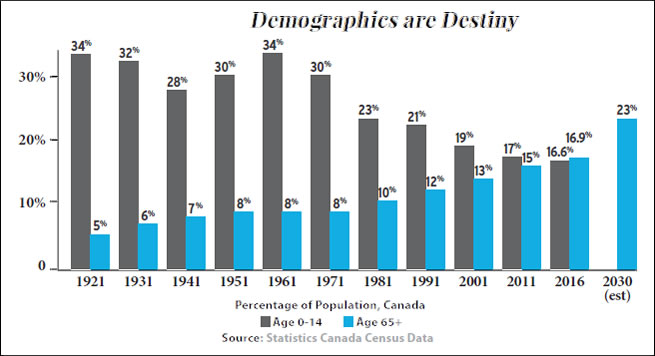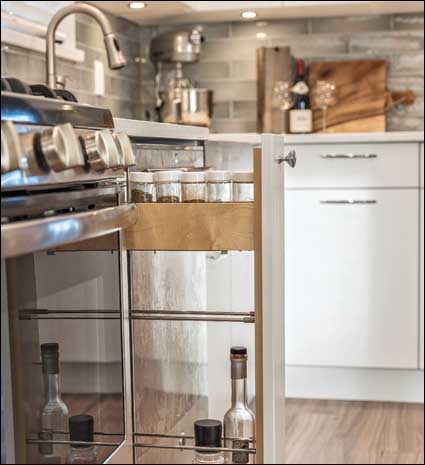by Elizabeth Malcolm, CHBA Communications and Social Media Officer
The oft-repeated phrase, “Demographics is Destiny” dates back to an obscure 19th century Frenchman, but it remains true today. The saying has taken on new meaning as Canada’s population goes through an unprecedented shift in age distribution.
We are all aware of the aging of Canada’s population, but both the extent of this trend, and the opportunities it opens for CHBA’s renovator members, are more significant than most of us realize.

CHBA is about to change that by launching the new Canadian Aging-in-Place Specialist program (C-CAPS) this fall. This member-service Get ready for initiative has been a high priority for CHBA’s Home Modification Council, as well as the Canadian Renovators’ Council, both of which have collaborated in its development.
Drawing on the well-established CAPS program developed in the U.S. by the National Association of Home Builders, C-CAPS is a truly Canadian version, designed and developed specifically for CHBA renovators.
The C-CAPS training and certification program aims to get out in front of a huge demographic wave on the way, and help renovators to get themselves set up to service – and capitalize on – this growing market.
The “grey wave”

According to Statistics Canada, in 2014 there were more than 6 million Canadians who were aged 65 or older, representing 15.6 percent of Canada’s population.
By 2030 – less than 11 years from now – seniors will number more than 9.5 million and make up 23 percent of Canadians.
As the chart, “Demographics are Destiny,” shows, this is the culmination of a long-term trend that has seen the number of seniors in Canada overtake the number of children, reversing a demographic relationship that had been in place since before Canada became a country.
Improved healthcare and longevity mean that someone aged 65 today can expect to live another 20 years or so. As a result, new parents today will likely have to care for their elder relatives longer than for their own children.
Between 1921 and 2005, average life expectancy at birth rose substantially in Canada, from 58.8 to 78 years for men and from 60.6 to 82.7 years for women. In all likelihood, the trend to increasing longevity will continue to swell the ranks of Canada’s senior population even further in the years ahead.
The home modification market
With so many more seniors, the key question for our industry becomes, “Where are they all going to live?”
Contrary to what many demographers forecast in the past, the overwhelming majority of Canadian seniors want to stay right where they are. They much prefer to age-in-place in a home and neighbourhood they know than to downsize into a condo or seniors-only community.
And this is where the C-CAPS program comes into the picture.
An aging population will have more complex housing needs, particularly if most seniors intend to stay put in their current home. Simply put, as we age we will inevitably encounter a range of mobility and other health-related challenges. Challenges our homes were not designed to accommodate easily.
So aging-in-place will require modifications to our homes that respond to our specific needs and challenges – mobility and otherwise. And everyone’s needs will be somewhat unique.
Delivering these modifications will require an industry that has the knowledge and the professional connections to do the job right.
That’s what C-CAPS will provide to Association renovators: technical and design training, product and material knowledge, and a solid understanding of who they need to have on their team to deliver high-quality results.
CHBA is also developing a consumer website to provide information to the public about aging-in-place, available home modification grants and assistance, and to promote C-CAPS renovators.
How big is this market? If we include mobility assistance devices and other products designed to support aging-in-place, estimates range up to $30 billion per year. And growing.

Not just another renovation
While many seniors needing home modifications may well have had previous renovation work done on their home, they will need an expert with specialized knowledge and experience to help them age-in-place. And until now, finding such professionals has been extremely difficult.
Home modifications involve a very specialized range of skills. Obviously, the renovator must know about how the physical space needs to be designed, and how to integrate and install mobility assistance and other devices and products.
But home modification also involves other professionals, like occupational therapists (OTs), who are critical in developing a modification plan that addresses homeowners’ specific needs, both today and in the future. Collaborating with OTs, designers, architects, and building officials requires a different approach than is typical in general renovations. In many cases, health authorities and insurers may also need be part of the team.
The C-CAPS approach
Earning a C-CAPS designation will require training. The CHBA program involves a prerequisite online course with subsequent in-class sessions, both of which will include testing.
Successful completion of both parts of the course will earn you your C-CAPS certificate. An additional online training module focusing on marketing and sales for business owners will also be available.
As the course rolls out, CHBA expects to introduce continuing education requirements for C-CAPS renovators to keep everyone up-to-date as many things in this area are changing fast in terms of technology improvements, especially in the area of electronics and networked medical devices.
Why being ahead of the curve matters
Clearly, C-CAPS will position CHBA renovators as the go-to professionals for those needing aging-in-place home modifications. In fact, it opens up a new upselling opportunity for anyone doing a renovation project for homeowners who expect to age-in-place, but currently have no mobility issues. And it will create significant business opportunities for C-CAPS renovators to work with other healthcare professionals, such as OTs.
Perhaps most importantly, it will provide consumers with a reliable way to identify competent home modification professionals. Seniors have long been targetted by unscrupulous contractors, and C-CAPS will help reduce this problem.
Finally, by helping to make aging-in-place a more practical option for older Canadians, Canada’s healthcare system will benefit tremendously. Too often, seniors end up in an assisted living facility long before necessary, simply because they can no longer cope in their homes. The public cost of such unnecessary institutionalization is immense, and likely not sustainable.
Creating a national group of professional C-CAPS renovators is a major step in addressing this problem.
For updates, email C-CAPS@chba.ca











